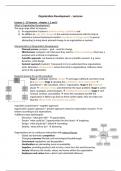Organization Development – Lectures
Lecture 1 – 29 January – chapter 1, 2 and 3
What is Organization Development?
The long-range effort to improve:
1) An organization’s/system’s problem-solving capabilities and
2) Its abilities to cope with changes in the external environment with the help of
external or internal behavioral-scientist consultants or change agents (a person
attempting to bring about planned change to an organization or system).
Characteristics of Organization Development
- Planned process: purpose – goal – need for change
- Effectiveness: company’s do it because they want to achieve something, they have a
purpose such as finical or employees.
- Scientific approach: not based on intuition, but on scientific research. E.g. team
dynamics, work design.
- Systemic approach (system): framework to try to understand how organizations
work. Elements/interdependent actors that work in organizations. Influence other
parts of the organization.
Research process for an OD consultant
Stage 1: anticipate need for change not longer sufficient, but there must
be a felt need. Stage 2: develop the practitioner-client relationship
practitioner = OD consultant, client = organization. Stage 3: the diagnostic
phase collection of data and determine the exact problem. Stage 4: action
plans, strategies, and techniques creating the intervention. Stage 5: self-
renewal, monitor, and stabilize when the consultant had left the
organization is likely to go back to there earlier habits. How we make sure
that the effects of the intervention stay stable.
Inquisitive acquirement = negative approach
Appreciative acquire approach = positive approach. Based on expectation research we
behave according to our expectations.
4 different steps (philosophy)
- Discovery: ‘what gives life?’ appreciating
- Dream: ‘what could be?’ (opportunities for the future) imagining
- Design: ‘what should be?’ (ideal) innovating
- Destiny: ‘what will we do?’ delivering
Organizations are in continuous interaction with external forces:
- Global and domestic competitors
- Changing consumer lifestyle and technological breakthrough
- Government regulations and deregulation
- Stockholders are demanding more accountability
- Suppliers, providing products and services, come form the world economy
- Society influences the modes, values and norms within the organization
- Employees and unions have a direct and substantial influence.
,Major trends shaping change:
1. Globalization & environment protection
2. Information technology/digitalization
3. Managerial innovation
In the past was everything very predictable and efficient. Now we are part of multiple teams,
have multiple tasks which lead to fluent, boundaryless organizations.
With globalization there are different set of rules for different regions.
System = a set of interrelated parts unified by design to achieve
some purpose or goal.
Systemic approach: individuals are connected within teams and
teams are connected with each other. The relation they have with
other organizations has effect on the organization itself Open
systems:
- Organizations continually interact with their environments;
- Feedback from the environment helps the system to adapt;
Forms of organizational adaptation
A stable environment = unchanging basic products and services, a
static level of competition, a low level of technical innovation, a formal
and centralized structure, and a slow, steady rate of growth.
A hyperturbulent environment = rapidly changing product lines, an
increasing and changing set of competitor, rapid and continual
technological innovation, and rapid market growth.
Sluggish thermostat management = resist change until cost trade-offs
favor it. Low risk, with formalized procedures and a high degree of structure and control.
Typically utilize with very stable goals and a highly centralized structure.
Satisficing management = adequate and average. Centralized decision-making structure with
problems referred to the top. More levels of management with coordination done by formal
committees.
Reactive management = tend to deal with problems on a short-run, crisis basis. Reacting to a
stimulus after conditions in the environment have changed. Waiting until serious problems
emerge that can no longer be ignored and then taking drastic and corrective measures.
Renewing/transformational management = introducing change to deal with future
conditions before these actually occur.
Socio-technical systems
An organization has an environment with different systems who react to and influence other
system elements (interdependent).
- Technical subsystem: primary functions, operations and equipment for the output.
- Structural subsystem: organizational structure design, policies and procedures.
- Psychological subsystem (culture): network of social relations
- Goals and values subsystem: mission and vision
, Managerial subsystem = spans the entire organization by
directing, organizing, and coordinating all activities toward
the basic mission.
Changing the culture
Culture is a system of shared values and beliefs that
interact with an organization’s people, structure and
systems to produces behavioral norms the way we do
thing around here.
It includes:
- Artifacts: cloths, language, behaviors;
- Norms and values: unwritten rules;
- Deep assumptions.
Lecture 2 – 1 February – chapter 4, 5 and 6 – understanding OD process, resistance to
change and interventions
Chapter 4: the diagnostic process stage 3
The identification of problems and areas for improvement is an important element in
developing a high-performance organization.
Organizational problem-solving means that every member of an
organization participates in developing a vision and improving the corporate
culture. You must know where you are before you can chart a course for
where you want to be The performance gap: difference between the
actual level of performance and a desired performance. May also occur when
the organization fails to adapt to changes in its external environment.
Diagnosis is a systematic approach to understanding and describing the present state of the
organization. The purpose of the diagnostic phase is:
- to gather information to specify the exact nature of the problem requiring solution,
- to identify the underlying causal forces,
- and to provide a basis for selecting effective change strategies and techniques.
Diagnosis as a process
1. Problem areas identified with the manager
2. Collect data: interview, observations,
questionnaires
3. Analyze data
4. Data feedback to client
5. Is there more data required to make diagnosis?
6. Client and practitioner jointly diagnose and identify
likely problem areas
7. Determine the client’s level of motivation to work
on the problem
8. Target systems are identified and the change
strategy is designed




